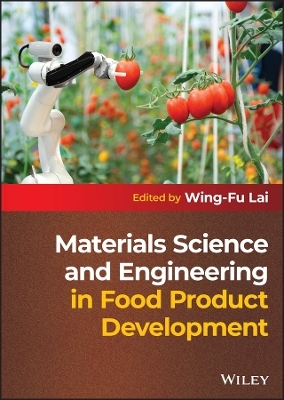
Materials Science and Engineering in Food Product Development
John Wiley & Sons Inc (Verlag)
978-1-119-86035-8 (ISBN)
In Materials Science and Engineering in Food Product Development, distinguished researcher Wing-Fu Lai delivers an authoritative exploration of the roles played by materials science and engineering in food product development. In the book, the authors employ a practical, industrial perspective to illustrate how food products, especially functional foods, can benefit from the incorporation of materials science technologies.
The book includes helpful glossary sections in each chapter, as well as important notes to highlight information useful to food manufacturers engaged in the real-world development and manufacture of foods. This book is appropriate for both early and advanced researchers interested in the design, improvement, and engineering of food products using the most current advances in food materials science.
Readers will also find:
A thorough overview of the most critical advances in food materials science
Comprehensive explorations of a materials science approach to food product design and discussions of techniques for the characterization of food materials and products
Practical discussions of the design and use of hydrogels, polymers, and lipid-based systems for food component encapsulation
Comprehensive treatments of the optimization of pasting and textural properties of food products by rheological manipulation
Perfect for students, researchers, and scholars in the fields of nutritional science, materials engineering, food science, food engineering, and nanotechnology, Materials Science and Engineering in Food Product Development will also benefit food manufacturing professionals during food product development.
About the Editor Wing-Fu Lai received his MSc degree in Materials Engineering and Nanotechnology from the City University of Hong Kong, and earned his PhD in Chemistry from the University of Hong Kong. He has been accredited as Shenzhen Municipal “Overseas High-caliber Personnel”. Professionally, he is a Registered Nutritionist in the UK, and a Fellow of the UK Higher Education Academy. He has also received his Certified Food Scientist credential from the International Food Science Certification Commission in the US. His research focus lies in the development and engineering of polymeric materials for food and pharmaceutical applications.
Contents
About the Editor xiv
List of Contributors xv
Preface xix
List of Abbreviations xxi
1 Overview of Different Materials Used in Food Production 1
Nahed A. Abd El-Ghany and Mahmoud H. Abu Elella
1.1 Introduction 1
1.2 Advanced Materials Engineering for Food Product Development 3
1.3 Encapsulation of Food Ingredients for Food Product Development 6
1.4 Food Packaging Approach for Food Product Development 13
1.5 Hydrogel Structures and Their Efficiency in Food Development 17
1.6 Conclusion 18
Glossary 19
References 20
2 Introduction to Food Properties and Techniques in Food Product Development 27
Sara A. Al-Hafiry, Omar A. Alaboudi, Ghada A. Ahmed,and Abdulrahman M. Abdulrahman
2.1 Introduction 28
2.2 Structural Impact on Properties 28
2.3 Food Consumer Demands 31
2.4 Food Properties to Be Improved 31
2.5 Food Materials Synthesis Techniques 34
2.5.3 3D Printing 36
2.6 Concluding Remarks 37
Glossary 37
References 38
3 Basic Concepts of Bulk Rheology in Food Emulsions 41
Carlos Bengoechea, Estefanía Álvarez-Castillo, José Manuel Aguilar, and Antonio Guerrero
3.1 Introduction 41
3.2 Emulsification Process 42
3.3 Rheology of Continuous Phase 44
3.4 Rheology of Emulsions 45
3.5 Microstructure 48
3.6 Destabilization Mechanisms 49
3.7 Concluding Remarks 52
Acknowledgments 52
Glossary 52
References 54
4 Understanding Interfacial Rheology in Food Emulsions 57
Cecilio Carrera, Manuel Felix, María Luisa López-Castejón, and Víctor Manuel Pizones
4.1 Introduction 57
4.2 Interfacial Engineering of Food Emulsifiers 58
4.3 Rheological Techniques for the Characterization of Interfacial Films 60
4.4 Concluding Remarks and Future Perspectives 68
Acknowledgments 69
Glossary 69
References 69
5 Overview of Types of Materials Used for Food Component Encapsulation 73
Zahra Emam-Djomeh, Mohammad Ekrami, and Ali Ekrami
5.1 Introduction 73
5.2 Major Techniques Used for Food Component Encapsulation 74
5.3 Materials Used as Carrier Source for Encapsulation 77
5.4 Protein-Based Carriers 78
5.5 Carbohydrate-Based Carriers 80
5.6 Lipid-Based Carrier 83
5.7 Roles Played by Materials in Food Component Encapsulation 86
5.8 Improved Dispersibility 87
5.9 Addition of Inhibitors 87
5.10 Reducing the Interactions 87
5.11 Control of Light Scattering and Absorption 87
5.12 Increased Bioavailability 87
5.13 Controlled or Targeted Release 88
5.14 Conclusions 88
Glossary 88
Reference 89
6 Design and Use of Microcarriers for the Delivery of Nutraceuticals 93
Maxim V. Kiryukhin, Su Hui Lim, and Cheryl Yingxue Chia
6.1 Introduction 93
6.2 Protection Against Environmental Conditions 96
6.3 Controlled Release by Responsive Carrier Material 100
6.4 Active Enhancement of M&Ns’ Bioavailability Through Microencapsulation 107
6.5 Conclusion 112
Glossary 113
Reference 114
7 Design and Use of Lipid-Based Systems for Food Component Encapsulation 117
Kalpani Y. Perera, Dileswar Pradhan, Shubham Sharma, Amit K. Jaiswal, and Swarna Jaiswal
7.1 Introduction 117
7.2 Lipid-Based Nano Delivery Systems for Food Component Encapsulation 121
7.3 Mechanism of Action of Encapsulated Food Components 127
7.4 Encapsulation of Food Components in Lipid-Based Nano Delivery Systems 129
7.5 Conclusion and Future Perspectives 134
Glossary 134
Reference 135
8 Working Principles and Use of Gelatin for Food Component Encapsulation 139
Youssef S. Abdelaziz, Rana Tarek, Donia G. Youssef, Mariam Khaled Abdel-Latif, Habiba Mohamad Ibrahim, Sohaila Mohammed Salah Saleh, and Heba M. Fahmy
8.1 Introduction 139
8.2 Why Use Gelatin in Encapsulation Technology? 140
8.3 Techniques for Food Encapsulation Using Gelatin 142
8.4 Microencapsulation Using Gelatin 145
8.5 Nanoencapsulation of Food Components Using Gelatin 149
8.6 Mechanisms of Release of Gelatin Encapsulation Systems for Food Components 153
8.7 Conclusion 155
Glossary 156
Reference 156
9 Working Principles and Use of Chitosan for Food Component Encapsulation 161
Gastón Bravo-Arrepol, Plamen Dimitrov Katsarov, Bissera Asenova-Pilicheva, Paolina Kancheva- Lukova, Danilo Escobar-Avello, Hazel Peniche, Lorenzo García, Carlos Peniche-Covas, Philippe Michaud, Cédric Delattre, Liliam Becheran-Maron, Johanna Castaño, Maria Dolores Lopez, Oscar Valdes, Aleksandra Nesic, and Gustavo Cabrera-Barjas
9.1 Introduction 162
9.2 Encapsulation Technologies 164
9.3 Agent Encapsulation Using Chitosan as Polymeric Matrix 166
9.4 Potential Applications of Microencapsulated Materials in Food Packaging 191
9.5 Market for Chitosan Uses in Food Application 199
9.6 Concluding Remarks 200
Glossary 201
Reference 201
10 Design and Use of Hydrogels for Food Component Encapsulation 209
Zahra Emam-Djomeh, Mohammad Ekrami, and Ali Ekrami
10.1 Introduction 209
10.2 Classification of Hydrogels 212
10.3 Hydrogel Formation 214
10.4 Recent Advances in Hydrogel Development 214
10.5 Retention and Release Properties 216
10.6 Applications of Hydrogels in Food Production 217
10.7 Conclusions 221
Glossary 221
References 222
11 Optimization of Pasting and Textural Properties of Food Products 227
Filopateer Nasser, Salma Hossam Mohamed, Mariam Ashraf Fouad Khalil, Omaima Ali Mostafa Mohammed, Radwa Magdy Mohamed, and Heba Mohamed Fahmy
11.1 Introduction 227
11.2 Physical and Chemical Modification of Starch Structures 228
11.3 Manipulation of Starch Properties Using Hydrocolloids 232
11.4 Enzymatic Modification of Starch Properties 234
11.5 Use of Starch Modification in Food Production 235
11.6 Concluding Remarks 236
Glossary 237
References 237
12 Phase Change Materials in Food Dryers 243
Hasibul Hasan Himel, Sabit Hasan, Nufile Uddin Ahmed, and Mahadi Hasan Masud
12.1 Introduction 243
12.2 Phase Change Materials and Their Properties 244
12.3 Potential of PCMs in Food Drying 250
12.4 Current Status of Utilizing PCMs for Food Drying 252
12.5 Recommendation for Optimization of PCM for Use in Solar Dryers 255
12.6 Concluding Remarks and Future Perspectives 257
Glossary 258
References 258
13 Multi-Functional Properties of Halloysite Nano-Clays in Food Safety and Security 261
Satwik Majumder and Saji George
13.1 Overview 261
13.2 Halloysite Nanotubes (HNT): A Versatile Natural Nanomaterial 263
13.3 Toxicity and Migration Associated with Halloysite 270
13.4 Future Perspectives 271
13.5 Conclusive Remarks 272
Glossary 273
References 273
14 Electrospinning Technologies for Encapsulation of Probiotics 279
Seethu, B.G., Aditya Sukumar P., Devikrishna P., Harshvardhan Kulkarni, Magdaline Eljeeva Emerald, Chandram Grover, and Heartwin A. Pushpadass
14.1 Introduction 279
14.2 Major Methods for Encapsulation of Probiotics 281
14.3 Conclusions 298
Glossary 299
References 299
15 Three-Dimensional Printing in Food Manufacturing and Mechanics 303
Stefania Chirico Scheele, Martin Binks, and Paul F. Egan
15.1 Introduction 303
15.2 Print Process 306
15.3 Material Preparation 308
15.4 Printing Parameters 309
15.5 Food Mechanics 311
15.6 Consumer Validation 314
15.7 Concluding Remarks 315
Glossary 316
References 316
16 Techniques for Characterization of Food-Packaging Materials 321
Shubham Sharma, Kalpani Y. Perera, Dileswar Pradhan, Brendan Duffy, Amit K. Jaiswal, and Swarna Jaiswal
16.1 Introduction 321
16.2 Characterization of Food-Packaging Material 323
16.3 Conclusion and Prospects 336
Glossary 337
References 337
17 Development and Use of Edible Materials for Food Protection and Packaging 341
Lin Lin, Mohamed Abdel-Shafi Abdel-Samie, Sherif M. Abed, and Haiying Cui
17.1 Introduction 341
17.2 Antimicrobial and Antioxidant Active Agents Used in the Field of Food Packaging 343
17.3 Carriers Applied in Food-Packaging Applications 345
17.4 Methods of Fabrication or the Enhancement Activity of Edible Packaging Films 349
17.5 Controlled Release of the BACs from Encapsulation Materials 353
17.6 Conclusion 353
Glossary 354
References 355
18 Packaging Design as Part of a Holistic Food Quality Assurance Process 361
Agnieszka S. Cholewa-Wójcik and Agnieszka K. Kawecka
18.1 Introduction 361
18.2 Essence of Quality-Oriented Product Designing and Its Role in Quality Assurance 362
18.3 Quality-Oriented Product-Designing Process 362
18.4 Integrated Product Designing as the New Approach to Packaged Product Designing Process 365
18.5 Methods to Aid Shaping of Quality of Products Being Designed 370
18.6 Concluding Remarks and Future Perspectives 371
Acknowledgments 372
Glossary 372
References 372
19 Determinants of the Quality and Safety of Food Packaging 377
Agnieszka K. Kawecka and Agnieszka S. Cholewa-Wójcik
19.1 Introduction 377
19.2 Literature Review Concerning Food-Packaging Safety 378
19.3 Packaging Safety Hazards 379
19.4 Legal Requirements for the Safety of Food Packaging 381
19.5 The Process of Ensuring Security – the Supply Chain 384
19.6 Packaging Safety Features and Attributes of Food Packaging 386
19.7 Concluding Remarks 388
Acknowledgments 388
Glossary 388
References 389
Index 393
| Erscheinungsdatum | 10.07.2023 |
|---|---|
| Verlagsort | New York |
| Sprache | englisch |
| Maße | 203 x 254 mm |
| Gewicht | 765 g |
| Themenwelt | Naturwissenschaften |
| Technik | |
| ISBN-10 | 1-119-86035-0 / 1119860350 |
| ISBN-13 | 978-1-119-86035-8 / 9781119860358 |
| Zustand | Neuware |
| Informationen gemäß Produktsicherheitsverordnung (GPSR) | |
| Haben Sie eine Frage zum Produkt? |
aus dem Bereich


